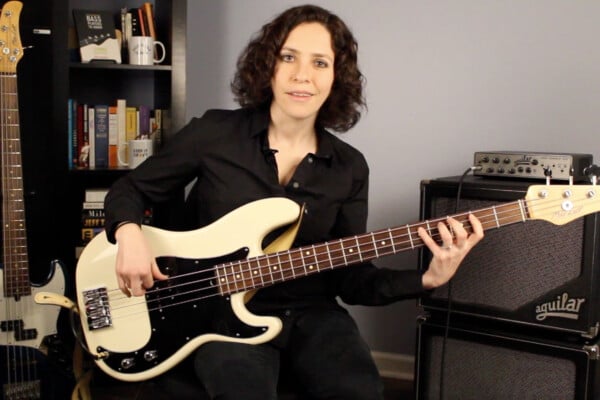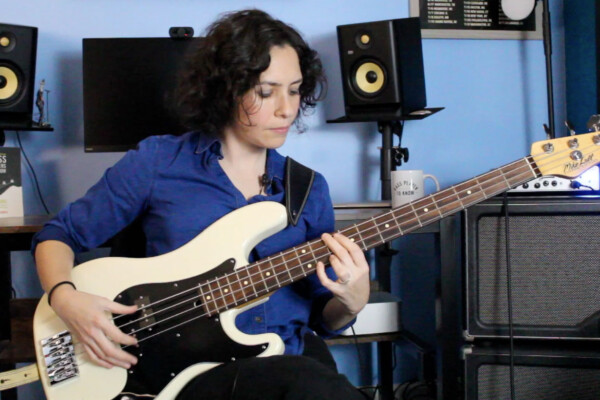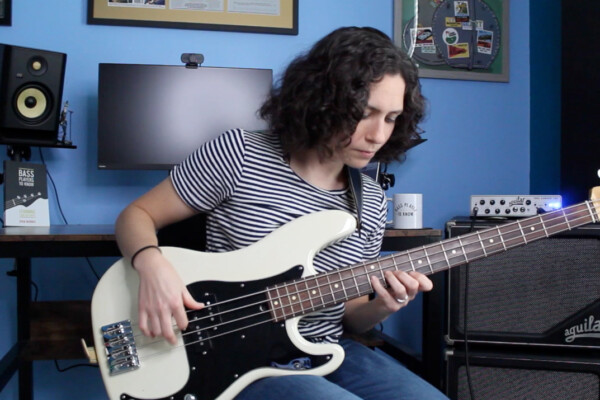Harmonizing the Major Scale: Using a Number System on Bass
This week, I’m kicking off a new lesson focusing on the foundation of music – the major scale. Read over this lesson and then be sure to check out the video for a demonstration.
Western music harmony is mostly based on the 7 steps of the major scale, and the chords built on the major scale are very common to music. It is important to memorize and transpose these chords, since they cover the bulk of the music you’ll play.
For example, most rock and pop tunes consist of simple chords and “easy” keys, such as C, G, D, Am and Em.
These chords are referred to as “diatonic”, which means they only use the notes contained in the major scale.
Build simple chords on each step of the major scale
Here, we’ll take the 7 steps of the major scale and build a simple chord on each of those steps. These three-note chords are also known as “triads”:
- C E G = a C Major triad, written as C
- D F A = a D minor triad, written as Dm or D-
- E G B = a E minor triad, written as Em or E-
- F A C = a F Major triad, written as F
- G B D = a G Major triad, written as G
- A C E = a A minor triad, written as Am or A-
- B D F = a B dimished triad, written as B0 or Bdim. (Note: this is not that common and is often changed to a G Major triad with B in the bass G/B)
So to build a triad from a scale, you play every other scale note. For example:
- C Major triad: 1st, 3rd and 5th step of the C Major scale (C E G)
- D minor triad: 2nd, 4th and 6th step of the C Major scale (D F A)
- E minor triad: 3rd, 5th and 7th step of the C Major scale (E G B)
Using the triads
So take another look at the chords formed by each step of the C Major scale:
C, Dm, Em, F, G, Am, Bdim
Translate that to the steps of the C Major scale:
1, 2m, 3m, 4, 5, 6m, 7dim
If we only use the Major chords from that group, we get:
C, F, G or the scale steps 1, 4 ,5
Those are the chords most commonly used in blues and rock progressions:
| C | C | C | C || F | F | C | C || G | F | C | G |
Or written as numbers (the scale steps) as many studio musicians do:
| 1 | 1 | 1 | 1 || 4 | 4 | 1 | 1 || 5 | 4 | 1 | 5 |
Reading (and writing) as numbers is a smart thing to do, because it allows you to transpose to any key more easily, because you’re only thinking about the scale steps.
So thinking in “C”:
| 1 | 4 | 5 | 1 | in C:| C | F | G | C |
And transposed to G:
| 1 | 4 | 5 | 1 || G | C | D | G |
For more great bass lessons from Thomas "MarloweDK" Risell, visit PlayBassNow.com.




marlow u r the man.
The number system, or as it’s known in the US – The Nashville Number System, is possibly the best tip that I learned years ago from fellow studio musicians. It has made it so much easier to communicate and play with other musicians, particularly, vocalists. Because, regardless of what key they sing or play in, once you have a song charted out, can you play along. And charting songs out are much quicker, too. A 4 chord is a 4 chord no matter if it’s in G or F#. Great video Marlow!
Alright !!
As usual, an excellent easy to understand description of this very useful concept. Thanks Marlow!
very helpful with getting it through my kids thick head… wonder where she gets it from….. that’s right her mother…. or maybe its really me….. mmmmmm nah.
that was a simple well stepped around stumbling block, thanks.
I always go with all of the notes have a place, as the octave 8 is always 2 strings over and 2 down, the 3 4 5 7 and everything else has a spot on the neck , and moveable. C of course has no sharps or flats in the scale, and is the only one. Seldom used B scale I play 135 as B D# F#. D as D F# A. By the way, I sat in with a blues group last Thursday and every number was in ADC or G. Stay well my friends.
A couple of things I’ve wondered about for a while are:
[1] How are the sharp and flat degrees notated?
1 b2 2 b3 3 4 b5 5 b6 6 b7 7.
C C# D D# E F F# G G# A A# B.
1 #1 2 #2 3 4 #4 5 #5 6 #6 7.
Top line or bottom line?
[2] If a song modulates, for example up a semi-tone, would you [a] notate the whole thing in the original key or [b] notate it in the new key where it changes with a note to that effect? The latter means that it’s much easier to spot ii-V7-I and other common progressions and much easier to learn.
well done Marllow…
I never knew anything about the number system. This just changed my world! I love it!
BDF=Bminor Flat 5!